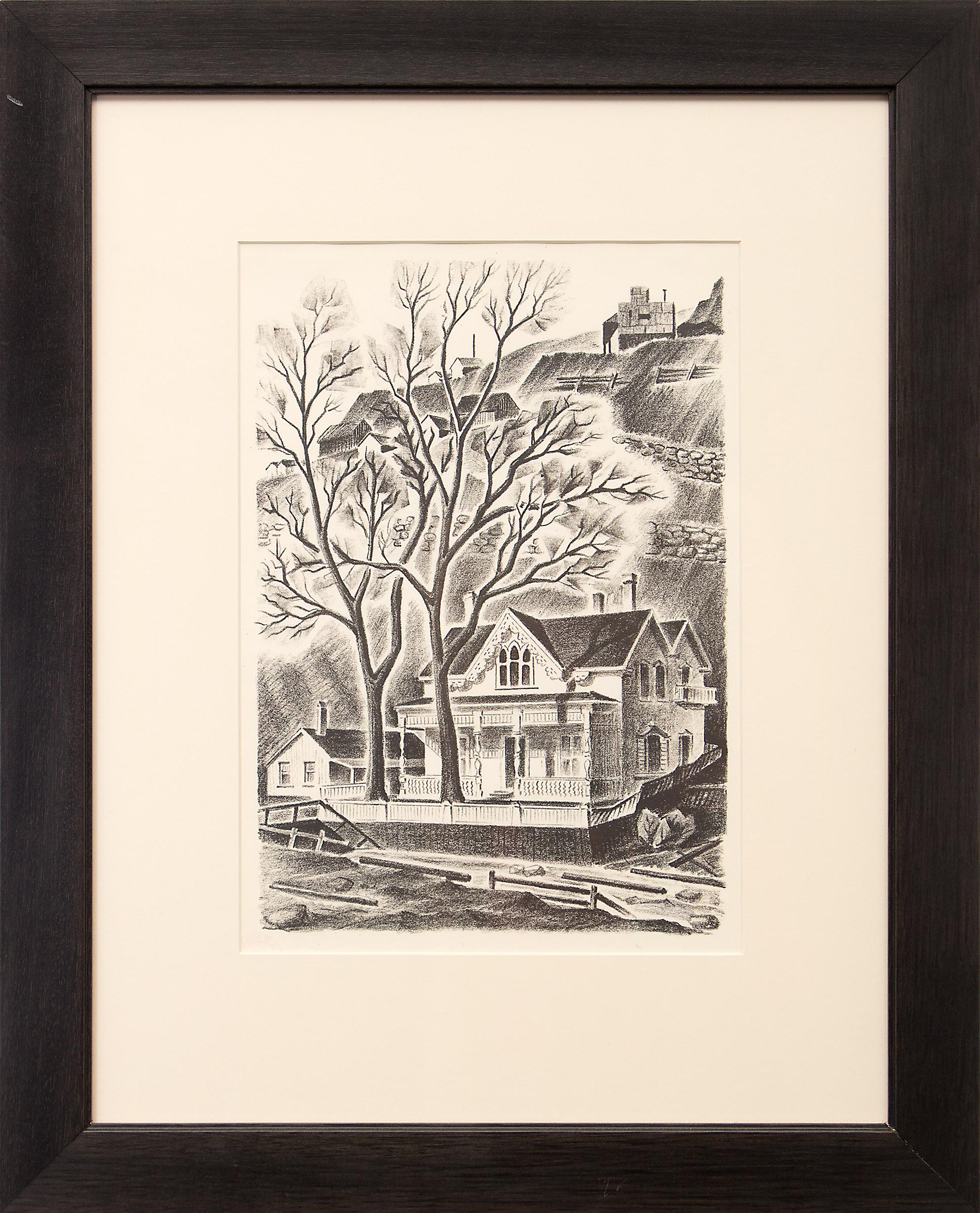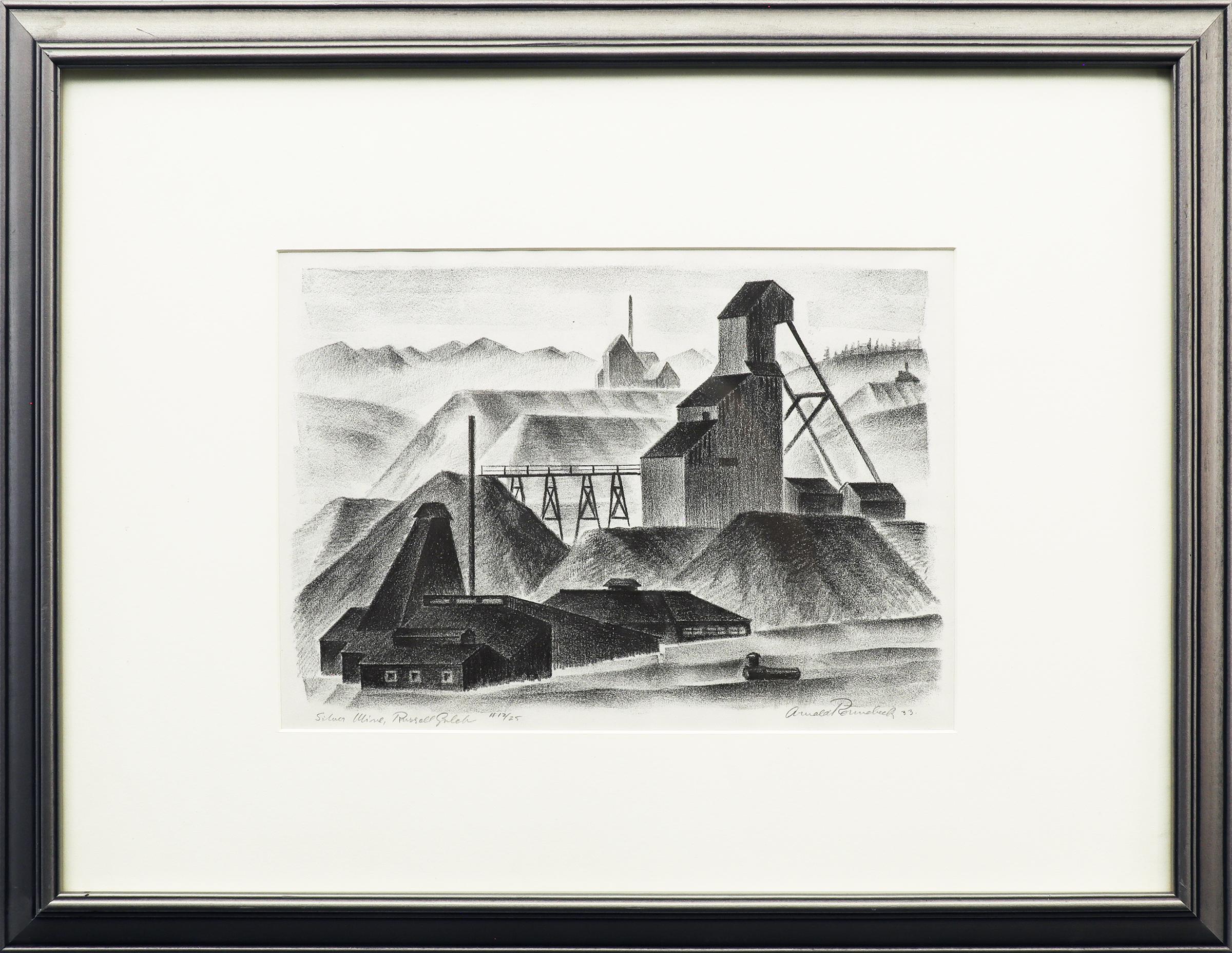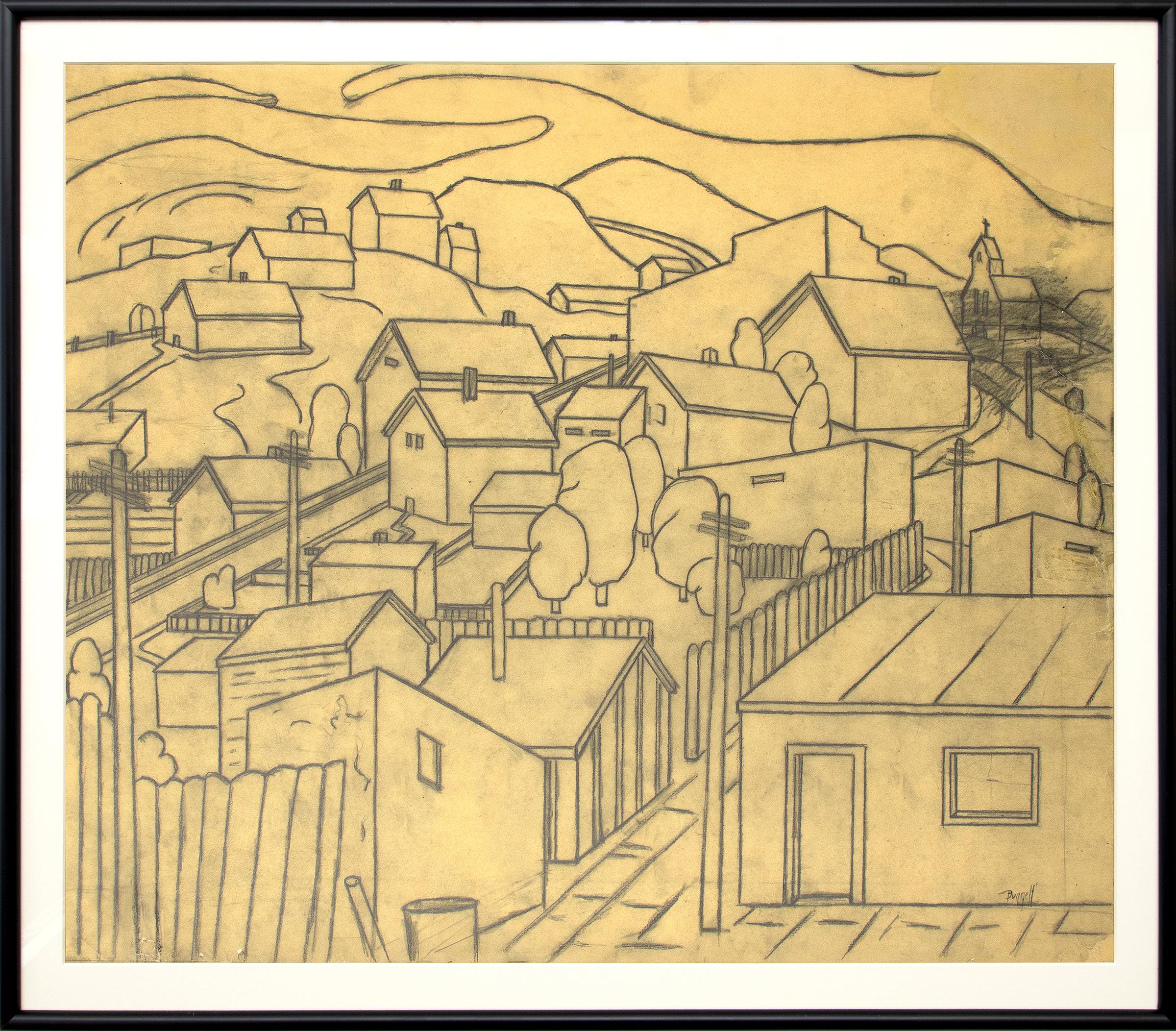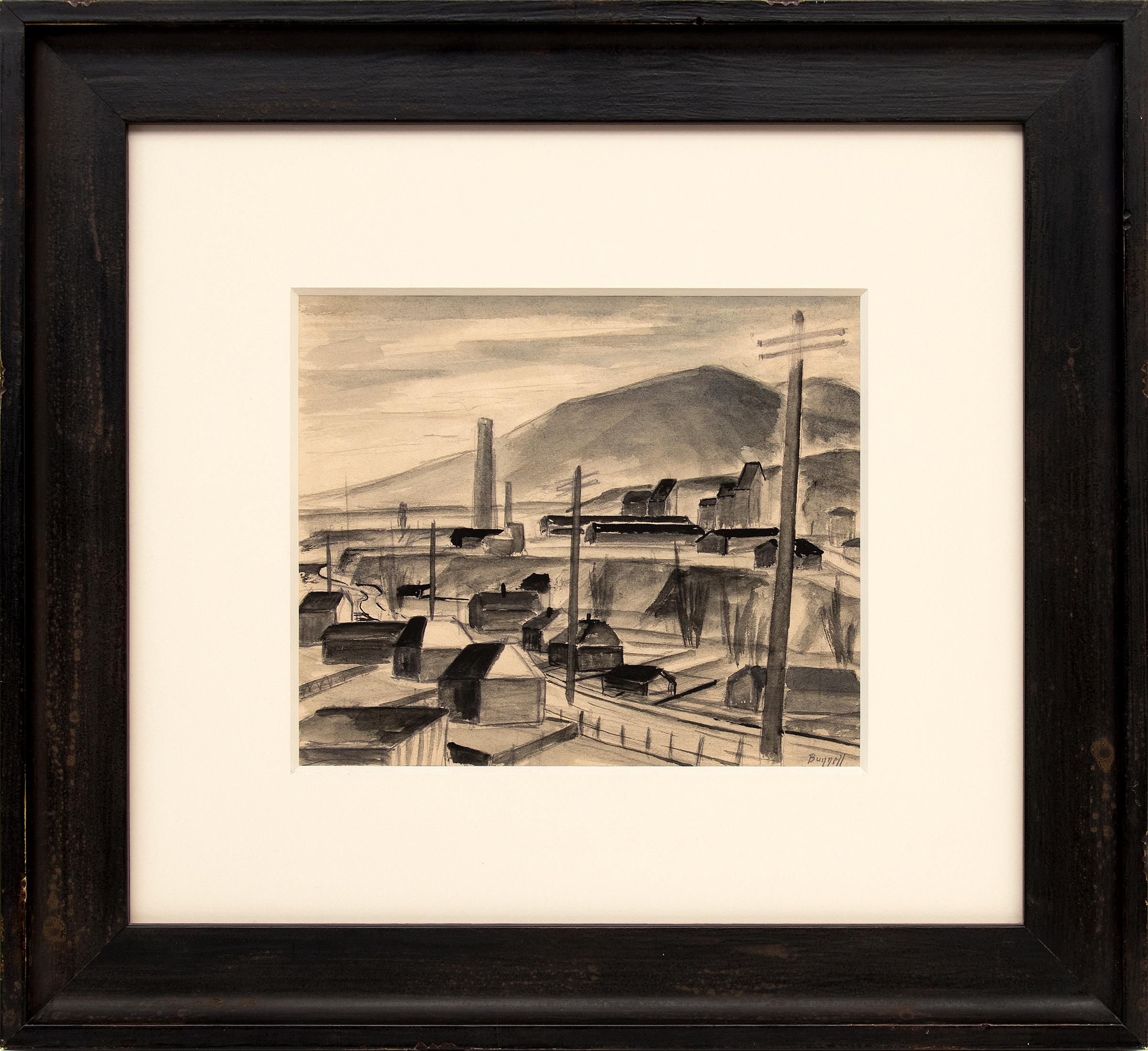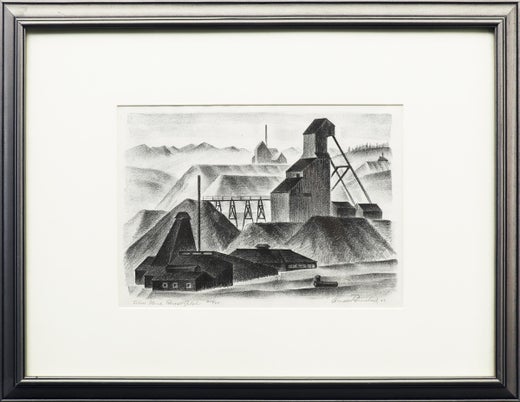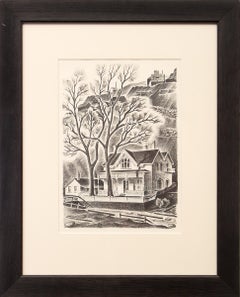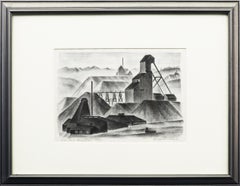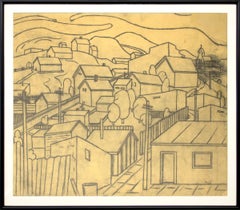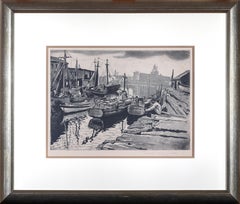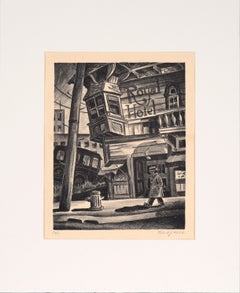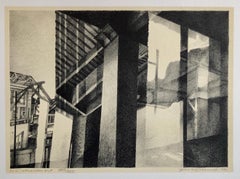Items Similar to WPA-Era Central City, Colorado, 1930s Modernist Lithograph, Cityscape 3/25
Want more images or videos?
Request additional images or videos from the seller
1 of 13
Arnold RönnebeckWPA-Era Central City, Colorado, 1930s Modernist Lithograph, Cityscape 3/251933
1933
$1,350
$2,75050% Off
£1,022.88
£2,083.6550% Off
€1,173.67
€2,390.8250% Off
CA$1,899.67
CA$3,869.6950% Off
A$2,088.26
A$4,253.8650% Off
CHF 1,097.49
CHF 2,235.6350% Off
MX$25,359.05
MX$51,657.3350% Off
NOK 13,690.94
NOK 27,888.9650% Off
SEK 12,971.21
SEK 26,422.8350% Off
DKK 8,759.43
DKK 17,843.2950% Off
About the Item
This 1933 lithograph, Central City, Colorado 3/25, by Arnold Rönnebeck, captures the architectural essence of a historic mining town during the Great Depression. Rendered in black and white, the piece showcases intersecting lines and planes, emblematic of Rönnebeck's "living cubism" style, reflecting the WPA-era's focus on American realism. The image size is 14¾ x 10 inches, presented in a custom black frame measuring 24½ x 19⅝ x ⅝ inches.
Provenance: Private collection, Denver
About the Artist:
Born in 1885, Arnold Rönnebeck was a pivotal figure in American modernism. After studying in Berlin and Paris, he settled in Denver in 1926. Rönnebeck's work, including this lithograph, reflects the WPA-era's commitment to depicting American life with precision and modernist aesthetics. His contributions to the Denver Art Museum and his involvement with the Central City Opera in 1933 underscore his deep connection to Colorado's cultural landscape.
- Creator:Arnold Rönnebeck (1885 - 1947)
- Creation Year:1933
- Dimensions:Height: 24.5 in (62.23 cm)Width: 19.5 in (49.53 cm)Depth: 0.5 in (1.27 cm)
- Medium:
- Movement & Style:
- Period:
- Framing:Frame IncludedFraming Options Available
- Condition:
- Gallery Location:Denver, CO
- Reference Number:Seller: 258311stDibs: LU27310303532
Arnold Rönnebeck
Modernist sculptor, lithographer and museum administrator, Rönnebeck was a noted member of European and American avant-garde circles in the early twentieth century before settling in Denver, Colorado, in 1926. After studying architecture at the Royal Art School in Berlin for two years beginning in 1905, he moved to Paris in 1908 to study sculpture with Aristide Maillol and Émile-Antoine Bourdelle. While there he met and befriended American modernist painter, Marsden Hartley, of whom he sculpted a bronze head that was exhibited at the Salon d’Automne in Paris in 1912 and the following year at Hartley’s solo show of paintings at Alfred Stieglitz’s Gallery 291 in New York. After World War I Rönnebeck traveled in Italy with German writer, Max Sidow, and German poet, Theodor Daubler, doing a series of drawings of Positano and the Amalfi Coast that formed the basis for his lithographs on the subject. The death of his finacée, the young American opera singer Alice Miriam in 1922 and his own family’s increasing financial problems in post-World War I Germany led him to immigrate to the United States in 1923. After living briefly with Miriam’s family in Washington, DC, he moved to New York where he became part of the avant-garde circle around Alfred Stieglitz. In the summer of 1925, as the guest of Mabel Dodge Luhan, Rönnebeck first saw Taos, New Mexico, which Marsden Hartley had encouraged him to visit. It was there that he met his future wife, Louise Emerson, an easel painter and muralist. A year later they were married in New York before relocating to Denver. He served as director of the Denver Art Museum from 1926 to 1930 where he invited Marsden Hartley to lecture on Cézanne’s art in 1928. Rönnebeck fostered the development of the museum’s collection of American Indian art and the curation of modernist art exhibitions. In addition to his work at the museum, he was professor of sculpture at the University of Denver’s College of Fine and Applied Arts from 1929 to 1935, and wrote a weekly art column in the Rocky Mountain News. In Colorado, the subject matter of his lithographs became the state’s landscape and its mining towns, as well as Native Americans from the pueblos in neighboring New Mexico. By the early 1930s Colorado’s old mining towns became a popular genre for artists because they were easily accessible, and their architectural components provided a welcome break from the nineteenth-century panoramic landscape tradition and the overwrought cowboy-and-Indian subject matter of the previous generation. As an amateur actor and music enthusiast, Rönnebeck had an additional connection with Central City. In June 1947, some five months before his death, the Denver Art Museum organized a solo exhibition of his sculptures, watercolors and prints. © copyright Stan Cuba for David Cook Galleries
About the Seller
5.0
Gold Seller
Premium sellers maintaining a 4.3+ rating and 24-hour response times
Established in 1979
1stDibs seller since 2013
295 sales on 1stDibs
Typical response time: 4 hours
- ShippingRetrieving quote...Shipping from: Denver, CO
- Return Policy
Authenticity Guarantee
In the unlikely event there’s an issue with an item’s authenticity, contact us within 1 year for a full refund. DetailsMoney-Back Guarantee
If your item is not as described, is damaged in transit, or does not arrive, contact us within 7 days for a full refund. Details24-Hour Cancellation
You have a 24-hour grace period in which to reconsider your purchase, with no questions asked.Vetted Professional Sellers
Our world-class sellers must adhere to strict standards for service and quality, maintaining the integrity of our listings.Price-Match Guarantee
If you find that a seller listed the same item for a lower price elsewhere, we’ll match it.Trusted Global Delivery
Our best-in-class carrier network provides specialized shipping options worldwide, including custom delivery.More From This Seller
View AllArnold Ronnebeck Lithograph of Gregory Point, Colorado, 1930s Modernist Print
By Arnold Rönnebeck
Located in Denver, CO
This original 1930s lithograph by renowned modernist artist Arnold Ronnebeck (1885–1947) captures a historic home at Gregory Point, near Central City, Colorado. Part of a limited edi...
Category
1930s American Modern Landscape Prints
Materials
Lithograph, Paper
Arnold Ronnebeck Lithograph "Silver Mine, Russell Gulch" Colorado Scene
By Arnold Rönnebeck
Located in Denver, CO
"Silver Mine, Russell Gulch (12/25)" is a striking black-and-white lithograph by German-born American Modernist Arnold Ronnebeck (1885–1947). This rare print depicts a historic minin...
Category
1930s American Modern Figurative Prints
Materials
Lithograph
Charles Ragland Bunnell 1935 Graphite Drawing, Colorado Modernist Cityscape
By Charles Ragland Bunnell
Located in Denver, CO
This circa 1935 graphite on paper drawing by Charles Ragland Bunnell (1897–1968) depicts a modernist cityscape of houses perched on a hill in Colorado, reflecting the vibrancy and in...
Category
1930s American Modern Landscape Drawings and Watercolors
Materials
Graphite
Charles Ragland Bunnell 1938 Ink Drawing of Church in Rocky Mountains, Colorado
By Charles Ragland Bunnell
Located in Denver, CO
This vintage 1938 ink drawing by Charles Ragland Bunnell (1897–1968) beautifully depicts a church nestled amid the dramatic Rocky Mountains of Georgetown, Colorado. Executed in bold ...
Category
1930s American Modern Landscape Drawings and Watercolors
Materials
Ink
1940s WPA-Era Abstract Watercolor of Golden Cycle Mill by Charles Ragland Bunnel
By Charles Ragland Bunnell
Located in Denver, CO
This original 1940s grayscale watercolor by Charles Ragland Bunnell captures a semi-abstracted view of the Golden Cycle Mill in Colorado Springs, Colorado. Rendered in subtle blacks and grays, this striking WPA-era landscape melds industrial subject matter with a modernist aesthetic. The piece exemplifies mid-20th-century American regionalism, blending expressive abstraction with historical significance.
The painting measures 8 1/8 x 9 5/8 inches (sight size) and is showcased in a custom black frame measuring 18 x 19 ½ x 1 ⅜ inches, making it an elegant addition to any collection of American art or industrial landscapes.
The Golden Cycle Mining and Reduction Company was a vital part of Colorado’s early 20th-century mining boom, located in what is now Old Colorado City. Bunnell’s work documents this industrial heritage through a modernist lens, offering a unique narrative of regional development.
About the Artist:
Charles Ragland Bunnell (1897–1968) was a key figure in Colorado’s art scene and a pioneer of American Modernism and abstraction. Trained at Broadmoor Art Academy, he combined American Scene painting with abstract forms. Bunnell contributed to New Deal art...
Category
1940s American Modern Landscape Paintings
Materials
Watercolor
1933 Arnold Rönnebeck Lithograph Colorado Mountain Mine Winter Scene, Framed
By Arnold Rönnebeck
Located in Denver, CO
This rare 1933 lithograph by renowned modernist artist Arnold Rönnebeck depicts a striking winter scene of a Colorado mountain mine blanketed in snow. Rendered in dramatic black-and-...
Category
1930s American Modern Landscape Prints
Materials
Lithograph
You May Also Like
New York City, The El at Chatham Square - Original lithograph , Handsigned / 100
By Adriaan Lubbers
Located in Paris, IDF
Adriaan Lubbers
New York City, The El at Chatham Square, 1930
Original lithograph
Handsigned in pencil
Numbered / 100
On Rives vellum 28 x 22.5 cm (c. 11 x 9 in)
Very good condition
Category
1930s American Modern Landscape Prints
Materials
Lithograph
Black and White Etching Travel 1930's Realism Water Industrial Outdoors Signed
By Joseph Margulies
Located in Milwaukee, WI
"Fishing Boats Gloucester" is a soft ground etching created by Joseph Margulies. The artist signed this piece in the lower right margin with graphite. This piece depicts several fish...
Category
1930s American Realist Landscape Prints
Materials
Ink, Etching, Aquatint
Royal Hotel - New Orleans 1920s Depression Art Lithograph in Ink on Paper
Located in Soquel, CA
Royal Hotel - New Orleans 1920s Depression Art Lithograph in Ink on Paper
Dramatic street scene with a man wearing a trench coat and hat by Robert J We...
Category
Late 20th Century American Modern Landscape Prints
Materials
Paper, Lithograph
Chicago Scene Modernist Architectural Lithograph, Nevada Artist
Located in Surfside, FL
Jim McCormick was born in Chicago in 1936. He attended the University of Tulsa where he received a bachelor’s degree in art in 1958, then a M.A. in paint...
Category
1980s American Modern Abstract Prints
Materials
Lithograph
Cincinnati Ohio cityscape drawing WPA era
Located in Wilton Manors, FL
Beautiful original drawing by American artist, Albert Sway (b.1913). Cincinnati Cityscape, ca. 1935. Ink on paper measures 9.5 x 12 inches. Signed lower right. Good condition with no...
Category
1930s American Realist Landscape Drawings and Watercolors
Materials
Paper, Ink
A ca. 1940s Graphite on Paper Mural Study of a City Scene by Rudolph Weisenborn
By Rudolph Weisenborn
Located in Chicago, IL
A ca. 1940s graphite on paper mural study of a Chicago city scene by notable Modern artist Rudolph Weisenborn. Artwork size: 12 1/2" x 9 1/4". Archivally matted to 18" x 16". Provenance: Estate of the artist.
Rudolph Weisenborn was born in Strassburg, Germany in 1881, but was orphaned at the age of nine. He was taken-in by Mid-Western farmer Thomas Westaby and spent his early years in Wisconsin, Iowa and North Dakota. Weisenborn first attended the University of North Dakota in 1898, then the Students School of Art in Denver. Various accounts have him working out west as a gold miner and cowboy.
Around 1912, he settled in Chicago and worked as a window designer for Marshall Field’s. Weisenborn is best known as the founder of the Chicago No-Jury Society of Artists. The group was founded because many artists could not get their work accepted into the mainstream Art Institute shows. Weisenborn is quoted as saying that he harbored feelings of disdain for any jury and that his own paintings were frequently rejected by conservative jurors. He was also involved and helped found other radical artist’s groups such as the Salon des Refuses, Cor Ardens and Neo-Arlimusic. In 1936, he helped found the New York-based American Abstract Artist’s Group. He created the only abstract mural for the 1933 Century of Progress Exhibition in Chicago and also worked for the Federal Arts Project in the Easel Division. His WPA murals can be found in Crane Technical High School and Nettlehorst Elementary School in Chicago, IL. In 1945, Chicago businessman Herman Spertus...
Category
1940s American Modern Landscape Drawings and Watercolors
Materials
Paper, Graphite
